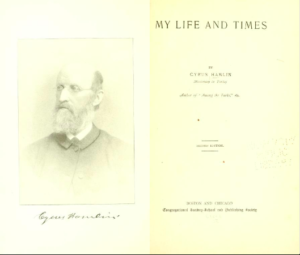In My Life and Times, Cyrus Hamlin recounts his long and impressive life story. The autobiography comes to 536 pages, and it covers his early childhood from his misdeeds as a child through his founding of Robert College and his life after the Crimean War. It ends with a discussion of his life as a whole, and his impact over the years.
Cyrus Hamlin had written this book as a promise to his children, and, in doing so, wrote like he was talking to them. Hamlin does a wonderful job of relating his life so that anyone could understand his actions and his reasoning for them. Of course, at points, Hamlin favored himself. He wrote about himself in a more positive light, and, according to the study done by Charles Stone, Olivier Luminet, and William Hurst, there is a scientific explanation for this. In their study, they found that when recalling positive memories, people tend to forget the memories that are associated with them whether they were good or bad. “When reminiscing about (positive) college memories,” they argue, “we would expect that the selective nature of this reminiscing would not only make related memories more inaccessible, but also lead the individual to have less confidence in these memories, which, prior to this reminiscence, they were quite confident they actually occurred.”[1] In other words, while this autobiography does have historical value, the content should be looked at more closely and reviewed, Hamlin’s subjectivity must be taken into account.
This same process can be seen in negative memories as well. Hamlin has the belief that he can only remember the negative memories in his childhood because they stood out the most to him. However, according to the study by Stone et al., despite his high confidence in remembering these events, they may still be inaccurate. According to the study, they found that Americans believe that they should never forget their 9/11 memories; thus, they must remember what is completely accurate. However, their German counterparts do not have this desire to remember 9/11, so their confidence about their memory is lower.[2] These memories, then, may be inaccurate, but the Americans believe them to be true. While not a direct correlation, the point remains: Hamlin might believe that he needs to remember these negative events in his past, but they might not be as accurate as he would like them to be. So, when one discusses an autobiographical work, the stories of the individual’s childhood and life need to be taken with some skepticism.
Hamlin’s My Life and Times is a source with tremendous detail about the life of Cyrus Hamlin. This autobiography gives unique insight into the Crimean War and the way a missionary can impact a war that spanned multiple countries. While this source is indeed subjective, it remains the most detailed account of the work Hamlin did throughout the Ottoman Empire. My Life and Times provides a unique look into the life of Cyrus Hamlin, and, without it, these stories and details would all be lost to time.
Notes
[1] Charles Stone, Olivier Luminet, and William Hurst, “Induced Forgetting and Reduced Confidence in Our Personal Past? The Consequences of Selectively Retrieving Emotional Autobiographical Memories,” Acta Psychologica 144, no. 2 (October 1, 2013), 255.
[2] Stone, Luminet, and Hurst, “Induced Forgetting,” 255.
